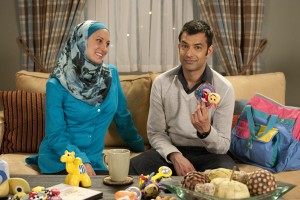Little Mosque on the Prairie: Jokes and the Contradictions of the Sitcom [Part 3]
 Jokes are an odd thing. They function through the excess of meaning they produce: we get a joke when we recognize the juxtaposition between what it says and what it means. We laugh because we are surprised. That surprise has a certain productive potential: it jolts us into seeing the world a little bit differently, if only for the duration of the joke. But seeing the world differently is a first step to questioning our assumptions about the world, including the stereotypes we maintain about people unlike ourselves.
Jokes are an odd thing. They function through the excess of meaning they produce: we get a joke when we recognize the juxtaposition between what it says and what it means. We laugh because we are surprised. That surprise has a certain productive potential: it jolts us into seeing the world a little bit differently, if only for the duration of the joke. But seeing the world differently is a first step to questioning our assumptions about the world, including the stereotypes we maintain about people unlike ourselves.
In my interviews with the makers of Little Mosque on the Prairie, it became clear that they recognized this, even if they might not have expressed it this way. They wanted Little Mosque to serve as a vehicle for this productive form of surprise, so that non-Muslim viewers would come to understand that the images of Muslims they saw in the news or on shows like 24 were partial and distorted. But they also recognized the economic and industrial constraints they faced in producing a sitcom, especially the need to please broadcasters and attract viewers and advertisers. They decided (quite deliberately) to follow the conventions of the sitcom, as Michael Kennedy, who directed more than thirty episodes over the show’s run, explains:
It was my belief, and the network executives’ strong recommendation, that the show would benefit best by being shot in a very clean and simple, straightforward manner, deliberately without any trendy contemporary stylish aspects such as handheld camera, etc. They wanted it to look very much like “a traditional sitcom.” It would be a traditional sitcom, with a very edgy topic. If it had been possible I am sure they would have shot it with 3 or 4 cameras in front of a live audience, like many successful American sitcoms.
In this respect, Little Mosque hewed to many of the conventions that mark the sitcom as fundamentally conservative, in particular the episodic structure of stasis-conflict-resolution-stasis. These conventions worked at cross-purposes with humor’s potential to draw people’s assumptions about the world into question.
So how did this situation play out? The many people involved in Little Mosque’s production negotiated their way between these conflicting forces throughout the show’s run, in ways that were registered in the program itself. To give only one example, the show’s mode of production changed when Little Mosque was picked up for a second season. Executive producer Mary Darling explains,
[S]eason 1 was … about issues, it was thoughtful, we had a lot of time to develop it. [In] season 2 we went … from a cottage industry [to] a factory model, and we brought in a show-runner who didn’t quite understand what it was we were trying to do. [As a result] we had a couple of decent episodes but we lost our way in that season, trying to be funny and relying too much on the jokes instead of the … relevant … conversation that’s happening in the world.
As Darling further explains, they reached a point where “if you just sort of forget about the rest of the world and just make funny episodes … then it’s just a bunch of funny people, some of whom are wearing a hijab.” In reaction to this situation, the executive producers, with the support of the show’s creator Zarqa Nawaz and the encouragement of people like the head of CBC comedy, Anton Leo, decided to abandon the conventional return to stasis. Darling explains:
So by the time we hit season 3, we went and talked to the CBC and said … we just thought with religion or spirituality or whatever word you want … to address transformational occurrences in a person’s life, there’s something measurable that goes with that, right? … I was feeling very much like we’re missing the heart now. We’re missing the thing where there’s a measurable transformation, so a character can have memory … I want there to be a memory of where we’ve been so that we can begin to measure where we want to go.
It was at that point that they introduced character and story arcs, an introduction that signaled a shift in the tension between the sitcom’s conservative nature and humor’s productive potential. When the sitcom’s conventions came to dominate the show in season 2, they decided to adjust course and change their approach to writing the show.
Negotiations such as these shaped the show for the rest of its run. It was because of them that the show was complicated and contradictory, allowing critics to see in it what they wanted to see. But that texture, nuance, and excess were also what made the show exportable, as I will discuss in my next entry.


